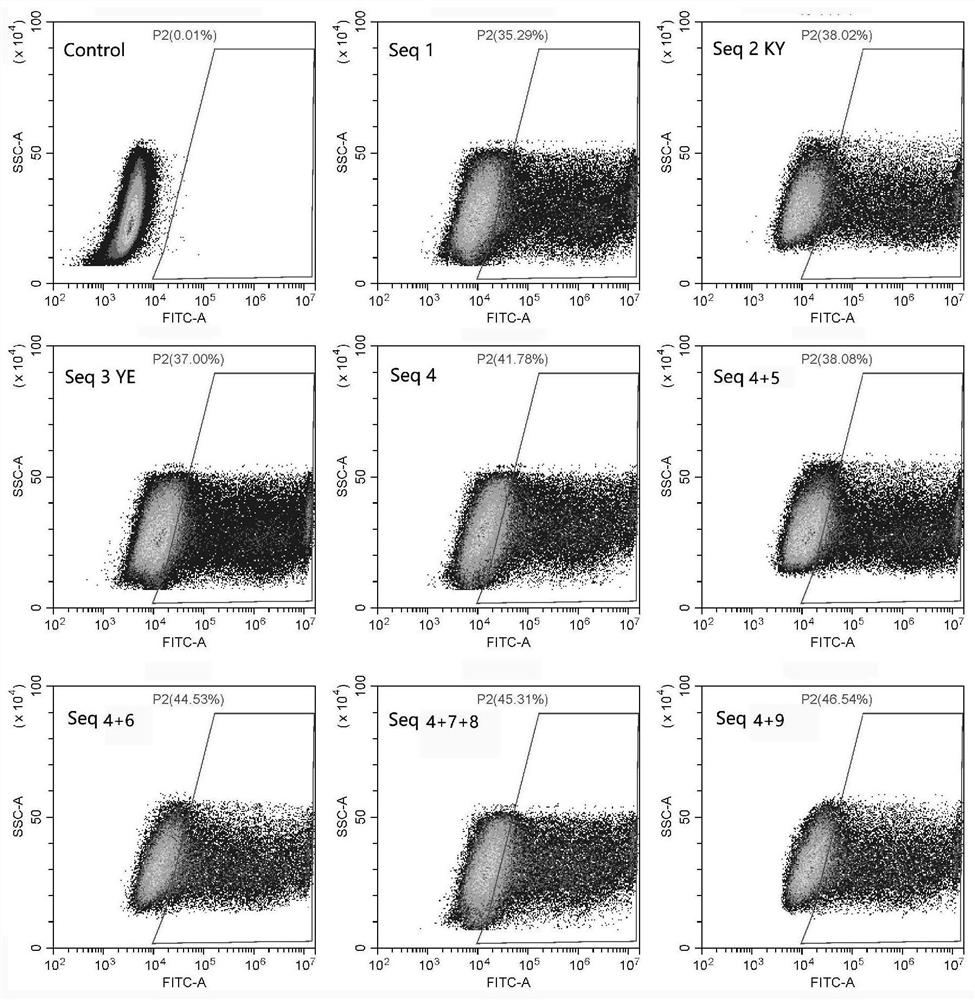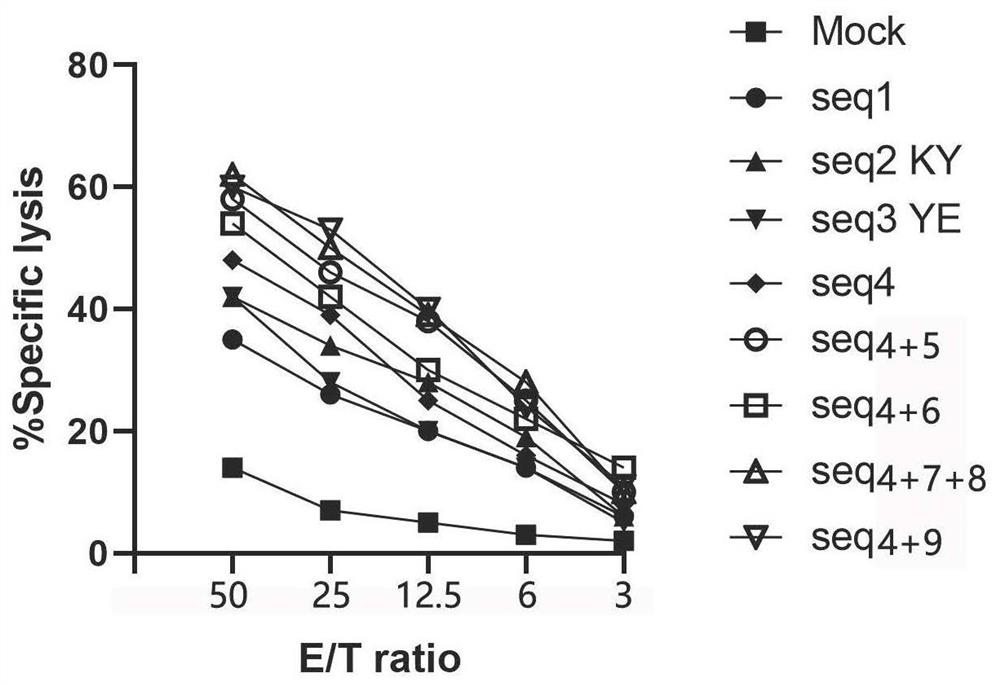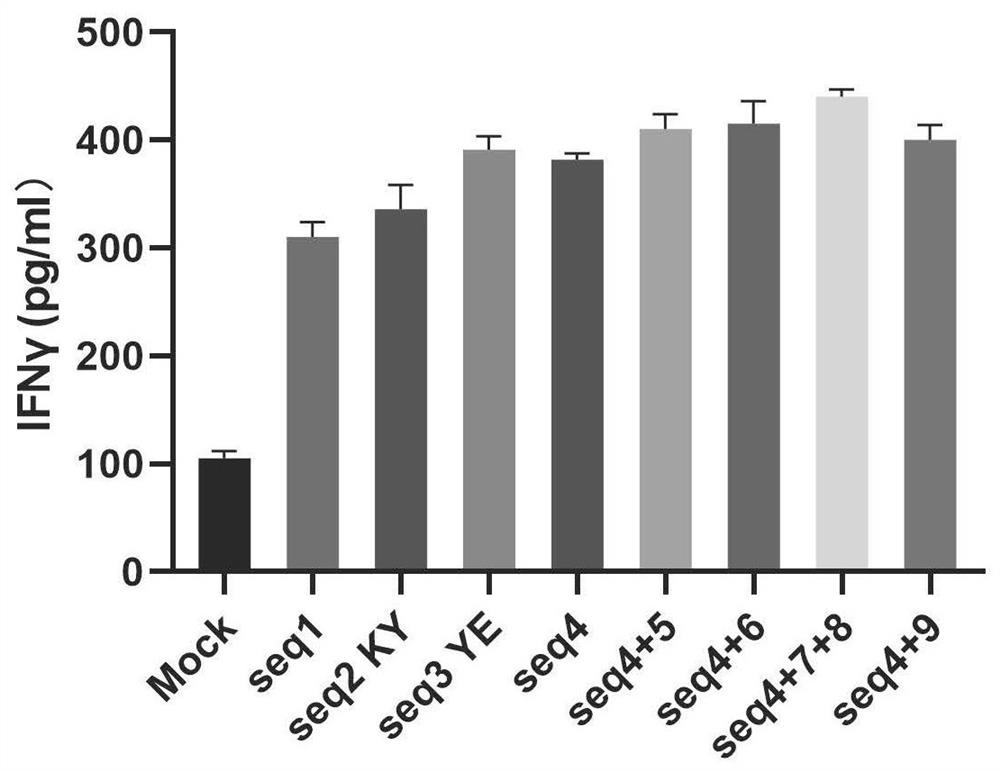mRNA for coding CAR gene, combined mRNA, construction method, CAR-T cell and application
A construction method and encoding technology, applied in the field of genetic engineering, can solve the problems of lack of target antigen, microenvironment, immune escape, etc., and achieve the effects of easy storage and transportation, treatment of malignant tumors, and simplified procedures
- Summary
- Abstract
- Description
- Claims
- Application Information
AI Technical Summary
Problems solved by technology
Method used
Image
Examples
Embodiment 1
[0042] Preparation of CAR-T cells
[0043] PBMC cells were isolated from the peripheral blood of healthy donors, cultured in AIM-V medium added with IL2 (50U / ML), CAR gene mRNA and cytokine mRNA according to seq1, seq2KY, seq3 YE, seq4, seq4+ 5. Cells were transfected with seq4+6, seq4+7+8, and seq4+9 respectively. After the cell culture was completed, the samples were taken and packed into sampling tubes for quality control testing.
[0044] The mRNA encoding the CAR gene, the nucleotide sequence is shown in SEQ ID No.1, referred to as seq1;
[0045] The mRNA encoding the CAR gene, the nucleotide sequence is shown in SEQ ID No.2, referred to as seq2 KY;
[0046] The mRNA encoding the CAR gene, the nucleotide sequence is shown in SEQ ID No.3, referred to as seq3 YE;
[0047] The mRNA encoding the CAR gene, the nucleotide sequence is shown in SEQ ID No.4, referred to as seq4;
[0048] The mRNA combination for preventing and treating tumors includes the mRNA encoding the CAR ...
Embodiment 2
[0069] In vitro killing experiments were performed on CAR-T cells made from peripheral blood. The specific experimental steps are as follows:
[0070] Step 1: Preparation of CAR-T cells
[0071] As in Example 1.
[0072] Step 2: Calcein-AM labeling target cells
[0073] 1) Dilute Calcein-AM to 1 mg / mL with DMSO;
[0074] 2) The human lymphoma cell line Daudi was resuspended into 1×10 6 Density / mL;
[0075] 3) Add 15ul of Calcein-AM, 37°C, 5% CO 2 Incubate for 30 minutes, and mix gently every 10 minutes;
[0076] 4) Centrifuge at 1500rpm, remove the supernatant, resuspend with medium, repeat twice;
[0077] Step Three: Kill
[0078] 1) Resuspend the labeled human lymphoma cell line Daudi at a density of 5000-50000 cells / mL, and add 100ul into a 96-well plate;
[0079] 2) Add 100 μl of CAR-T cells according to an appropriate ratio, so that the number ratios of CAR-T cells and cancer cells are 50:1, 25:1, 12.5:1, 6:1 and 3:1, 3 in each group Parallel; at the same time, t...
Embodiment 3
[0088] After the transfection of the CAR gene, the release of immune factors by T cells under the stimulation of the target cells was detected.
[0089] The CAR-T cells prepared in Example 1 were co-cultured with the human lymphoma cell line Daudi, and the supernatant and cell pellet were collected after 24 hours.
[0090] The human IFNγ detection kit (BD) was used in the supernatant to perform an ELISA test to detect the IFNγ content released by CAR-T cells after target cell stimulation. Cell pellets were detected by flow cytometry for endogenous cellular immune factors, and the antibodies used were allophycocyanin(APC)-Cy7-conjugated mAb to human CD8, PerCP-Cy5.5–conjugated mAb to human CD4, V450-conjugated mAb to human IFNg, PE-Cy7–conjugated antitumor necrosis factor (TNF) mAb, and flfluorescein isothiocyanate (FITC)-conjugated mAb to human IL2 (BD Biosciences). The result is as Figure 3-6 And shown in Table 3, 4, 5.
[0091] Table 3 The content of immune factor IFNγ exc...
PUM
 Login to View More
Login to View More Abstract
Description
Claims
Application Information
 Login to View More
Login to View More - R&D
- Intellectual Property
- Life Sciences
- Materials
- Tech Scout
- Unparalleled Data Quality
- Higher Quality Content
- 60% Fewer Hallucinations
Browse by: Latest US Patents, China's latest patents, Technical Efficacy Thesaurus, Application Domain, Technology Topic, Popular Technical Reports.
© 2025 PatSnap. All rights reserved.Legal|Privacy policy|Modern Slavery Act Transparency Statement|Sitemap|About US| Contact US: help@patsnap.com



